(完整版)形容词与副词的用法
- 格式:doc
- 大小:49.01 KB
- 文档页数:5
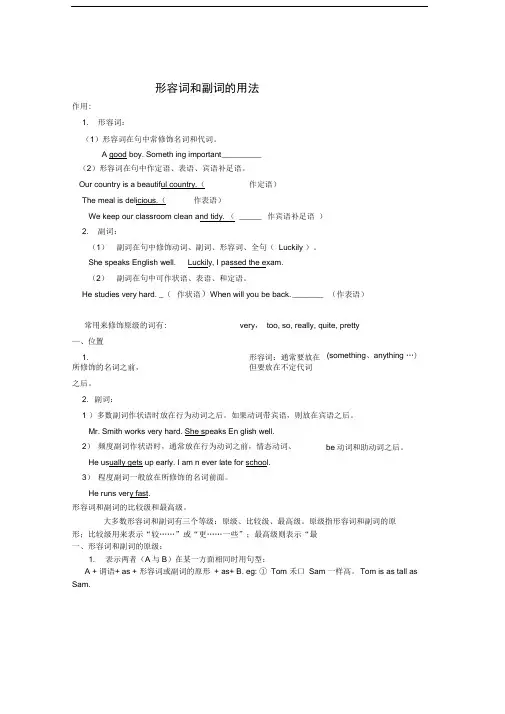
形容词和副词的用法作用:1. 形容词:(1)形容词在句中常修饰名词和代词。
A good boy. Someth ing important _________ (2)形容词在句中作定语、表语、宾语补足语。
Our country is a beautiful country.( 作定语)The meal is delicious.(作表语)We keep our classroom clean and tidy. ( _____ 作宾语补足语 ) 2. 副词:(1) 副词在句中修饰动词、副词、形容词、全句( Luckily )。
She speaks English well.Luckily, I passed the exam.(2) 副词在句中可作状语、表语、和定语。
He studies very hard. _( 作状语)When will you be back. _______ (作表语)very , too, so, really, quite, pretty—、位置1.形容词:通常要放在所修饰的名词之前, 但要放在不定代词之后。
2. 副词:1 )多数副词作状语时放在行为动词之后。
如果动词带宾语,则放在宾语之后。
Mr. Smith works very hard. She speaks En glish well. 2) 频度副词作状语时,通常放在行为动词之前,情态动词、 He usually gets up early. I am n ever late for school. 3) 程度副词一般放在所修饰的名词前面。
He runs very fast.形容词和副词的比较级和最高级。
大多数形容词和副词有三个等级:原级、比较级、最高级。
原级指形容词和副词的原形;比较级用来表示“较……”或“更……一些”;最高级则表示“最 一、形容词和副词的原级:1. 表示两者(A 与B )在某一方面相同时用句型:A + 谓语+ as + 形容词或副词的原形 + as+ B. eg: ① Tom 禾口 Sam 一样高。
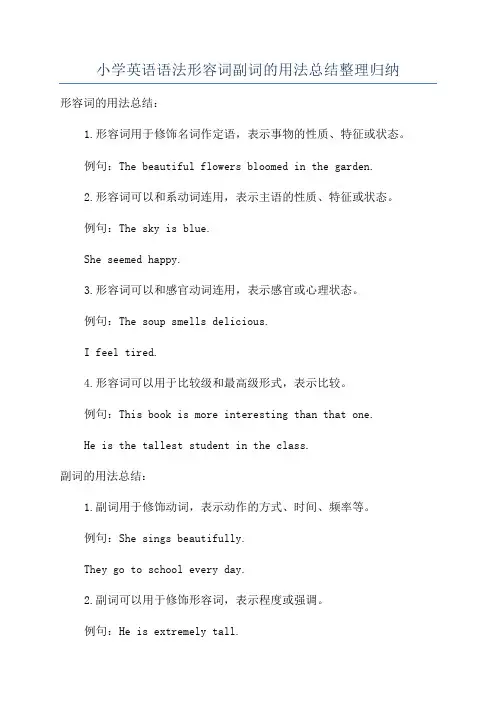
小学英语语法形容词副词的用法总结整理归纳形容词的用法总结:1.形容词用于修饰名词作定语,表示事物的性质、特征或状态。
例句:The beautiful flowers bloomed in the garden.2.形容词可以和系动词连用,表示主语的性质、特征或状态。
例句:The sky is blue.She seemed happy.3.形容词可以和感官动词连用,表示感官或心理状态。
例句:The soup smells delicious.I feel tired.4.形容词可以用于比较级和最高级形式,表示比较。
例句:This book is more interesting than that one.He is the tallest student in the class.副词的用法总结:1.副词用于修饰动词,表示动作的方式、时间、频率等。
例句:She sings beautifully.They go to school every day.2.副词可以用于修饰形容词,表示程度或强调。
例句:He is extremely tall.The movie is very interesting.3.副词可以用于修饰其他副词,表示程度、重复、频率等。
例句:She speaks English fluently.They arrived here quite recently.4.副词有些可以充当句子成分,如修饰整个句子的状语。
Honestly, I don't like his attitude.需要注意的是,有些词既可以作形容词又可以作副词,根据具体的句子语境来确定其词性。
另外,还有一些词在作副词时,其形式与形容词相同,只能根据句子中所修饰的词或作用来判断其具体词性。
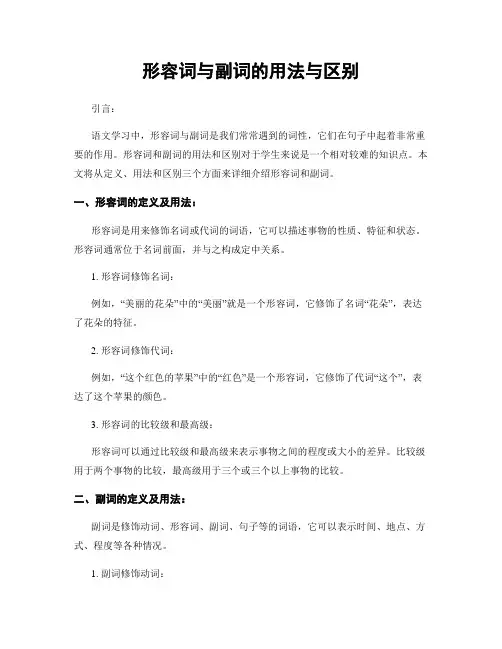
形容词与副词的用法与区别引言:语文学习中,形容词与副词是我们常常遇到的词性,它们在句子中起着非常重要的作用。
形容词和副词的用法和区别对于学生来说是一个相对较难的知识点。
本文将从定义、用法和区别三个方面来详细介绍形容词和副词。
一、形容词的定义及用法:形容词是用来修饰名词或代词的词语,它可以描述事物的性质、特征和状态。
形容词通常位于名词前面,并与之构成定中关系。
1. 形容词修饰名词:例如,“美丽的花朵”中的“美丽”就是一个形容词,它修饰了名词“花朵”,表达了花朵的特征。
2. 形容词修饰代词:例如,“这个红色的苹果”中的“红色”是一个形容词,它修饰了代词“这个”,表达了这个苹果的颜色。
3. 形容词的比较级和最高级:形容词可以通过比较级和最高级来表示事物之间的程度或大小的差异。
比较级用于两个事物的比较,最高级用于三个或三个以上事物的比较。
二、副词的定义及用法:副词是修饰动词、形容词、副词、句子等的词语,它可以表示时间、地点、方式、程度等各种情况。
1. 副词修饰动词:例如,“他快速地跑过去”中的“快速地”是一个副词短语,它修饰了动词“跑”,表示了跑的方式。
2. 副词修饰形容词:例如,“这个非常漂亮的女孩”中的“非常”是一个副词,它修饰了形容词“漂亮”,表示了漂亮的程度。
3. 副词修饰副词:例如,“他非常非常快乐地笑了”中的“非常非常”是一个副词短语,它修饰了副词“快乐”,表示了快乐的程度。
三、形容词和副词的区别:形容词和副词在用法上有一些明显的区别,主要体现在以下几个方面:1. 修饰的对象不同:形容词主要修饰名词或代词,描述事物的特征;副词主要修饰动词、形容词、副词等,表示事物的状态、方式、程度等。
2. 位置不同:形容词通常位于名词前面,与之构成定中关系;副词可以位于句首、句中或句末,修饰其他词语。
3. 词性不同:形容词属于形容词类,本身没有词性变化;副词既可以是原级,也可以是比较级或最高级。
4. 比较级和最高级的表示方式不同:形容词的比较级和最高级可以通过在词尾加上“-er”和“-est”来表示;副词的比较级和最高级通常在前面加上“more”和“most”。

形容词和副词的用法 It was last revised on January 2, 2021形容词和副词的用法作用:1.形容词:(1)形容词在句中常修饰名词和代词。
A good boy. Something important(2)形容词在句中作定语、表语、宾语补足语。
Our country is a beautiful country. (作定语)The meal is delicious. (作表语)We keep our classroom clean and tidy. (作宾语补足语)2.副词:(1)副词在句中修饰动词、副词、形容词、全句(Luckily)。
She speaks English well. Luckily, I passed the exam.(2)副词在句中可作状语、表语、和定语。
He studies very hard. (作状语) When will you be back.(作表语)注意:常用来修饰原级的词有:very,too, so, really, quite, pretty等一、位置1.形容词:通常要放在所修饰的名词之前,但要放在不定代词(something、anything…)之后。
2.副词:1)多数副词作状语时放在行为动词之后。
如果动词带宾语,则放在宾语之后。
Mr. Smith works very hard. She speaks English well.2) 频度副词作状语时,通常放在行为动词之前,情态动词、be动词和助动词之后。
He usually gets up early. I am never late for school.3) 程度副词一般放在所修饰的名词前面。
He runs very fast.形容词和副词的比较级和最高级。
大多数形容词和副词有三个等级:原级、比较级、最高级。
原级指形容词和副词的原形;比较级用来表示“较……”或“更……一些”;最高级则表示“最……”一、形容词和副词的原级:1.表示两者(A与B)在某一方面相同时用句型:A + 谓语 + as + 形容词或副词的原形 + as+ B.eg: ① Tom 和 Sam 一样高。

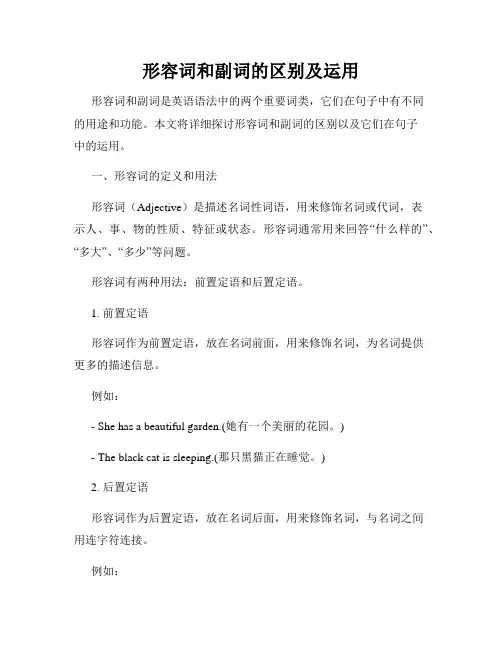
形容词和副词的区别及运用形容词和副词是英语语法中的两个重要词类,它们在句子中有不同的用途和功能。
本文将详细探讨形容词和副词的区别以及它们在句子中的运用。
一、形容词的定义和用法形容词(Adjective)是描述名词性词语,用来修饰名词或代词,表示人、事、物的性质、特征或状态。
形容词通常用来回答“什么样的”、“多大”、“多少”等问题。
形容词有两种用法:前置定语和后置定语。
1. 前置定语形容词作为前置定语,放在名词前面,用来修饰名词,为名词提供更多的描述信息。
例如:- She has a beautiful garden.(她有一个美丽的花园。
)- The black cat is sleeping.(那只黑猫正在睡觉。
)2. 后置定语形容词作为后置定语,放在名词后面,用来修饰名词,与名词之间用连字符连接。
例如:- The girl is kind-hearted.(这个女孩是善良的。
)- I bought a coffee table made of oak.(我买了一张由橡木制成的咖啡桌。
)二、副词的定义和用法副词(Adverb)是描述动词、形容词、副词和整个句子的词语,用来修饰动词、形容词、副词,表示行为的方式、程度、时间、地点等。
副词有多种用法:修饰动词、形容词和副词;修饰整个句子;表示时间、地点、方式、程度等。
1. 修饰动词副词可以用来修饰动词,表示行为的方式、频率、时间等。
例如:- He speaks English fluently.(他流利地讲英语。
)- They often go to the park on weekends.(他们经常在周末去公园。
)- She arrived late yesterday.(她昨天到达得很晚。
)2. 修饰形容词和副词副词可以用来修饰形容词或副词,表示程度或方式。
例如:- It is very hot today.(今天非常热。
)- He runs incredibly fast.(他跑得非常快。
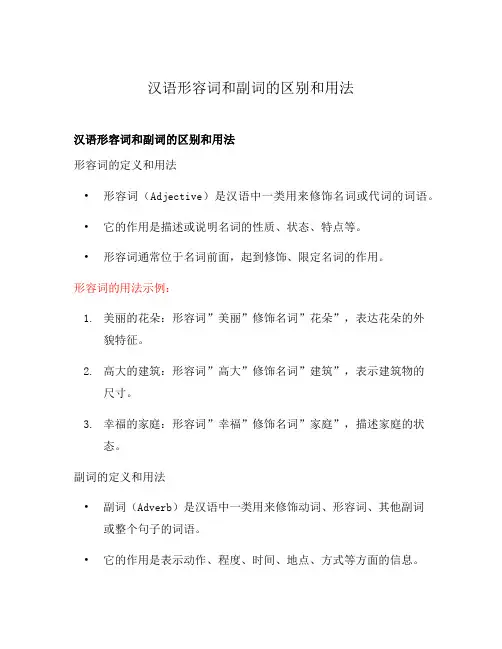
汉语形容词和副词的区别和用法汉语形容词和副词的区别和用法形容词的定义和用法•形容词(Adjective)是汉语中一类用来修饰名词或代词的词语。
•它的作用是描述或说明名词的性质、状态、特点等。
•形容词通常位于名词前面,起到修饰、限定名词的作用。
形容词的用法示例:1.美丽的花朵:形容词”美丽”修饰名词”花朵”,表达花朵的外貌特征。
2.高大的建筑:形容词”高大”修饰名词”建筑”,表示建筑物的尺寸。
3.幸福的家庭:形容词”幸福”修饰名词”家庭”,描述家庭的状态。
副词的定义和用法•副词(Adverb)是汉语中一类用来修饰动词、形容词、其他副词或整个句子的词语。
•它的作用是表示动作、程度、时间、地点、方式等方面的信息。
•副词可以修饰名词,但不像形容词那样紧密地与名词搭配。
副词的用法示例:1.快速奔跑:副词”快速”修饰动词”奔跑”,表示动作的速度。
2.非常漂亮:副词”非常”修饰形容词”漂亮”,表示程度的强烈程度。
3.安静地学习:副词”安静地”修饰动词”学习”,表示学习的方式。
形容词和副词的区别1.修饰对象不同:形容词修饰名词,副词修饰动词、形容词、其他副词或整个句子。
2.位置不同:形容词通常位于名词前面,副词通常位于动词或形容词之前。
3.作用不同:形容词描述名词的性质、状态、特点等,副词表示动作的方式、程度、时间、地点等信息。
形容词和副词的转换有一些词既可以做形容词又可以做副词,形容词和副词的转换通常通过词尾的变化来实现。
形容词和副词的转换示例:•形容词:“快乐的孩子”(形容词修饰名词)•副词:“他快乐地笑了”(副词修饰动词)注意事项•形容词和副词的用法需要根据具体上下文来确定,有些词既可以做形容词又可以做副词,需要根据语境来判断其功能。
•在具体写作中,可以根据需要使用合适的形容词和副词来修饰名词或动词,丰富文章的表达。
以上是关于汉语形容词和副词的区别和用法的介绍。
形容词和副词在修饰名词和动词时,起到不同的作用,需要根据具体语境来正确使用。
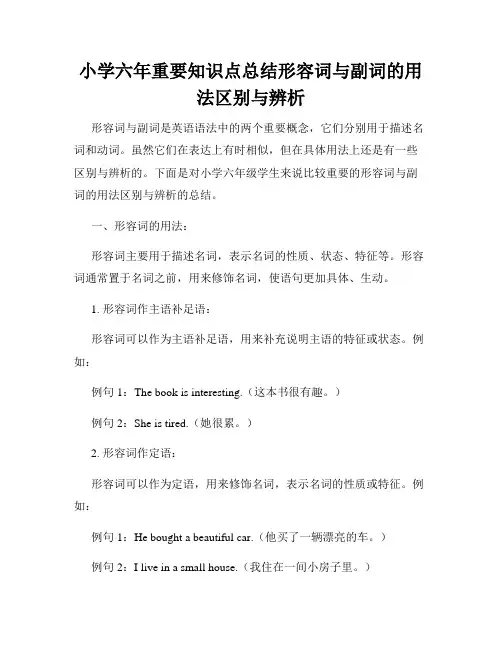
小学六年重要知识点总结形容词与副词的用法区别与辨析形容词与副词是英语语法中的两个重要概念,它们分别用于描述名词和动词。
虽然它们在表达上有时相似,但在具体用法上还是有一些区别与辨析的。
下面是对小学六年级学生来说比较重要的形容词与副词的用法区别与辨析的总结。
一、形容词的用法:形容词主要用于描述名词,表示名词的性质、状态、特征等。
形容词通常置于名词之前,用来修饰名词,使语句更加具体、生动。
1. 形容词作主语补足语:形容词可以作为主语补足语,用来补充说明主语的特征或状态。
例如:例句1:The book is interesting.(这本书很有趣。
)例句2:She is tired.(她很累。
)2. 形容词作定语:形容词可以作为定语,用来修饰名词,表示名词的性质或特征。
例如:例句1:He bought a beautiful car.(他买了一辆漂亮的车。
)例句2:I live in a small house.(我住在一间小房子里。
)3. 形容词作表语:形容词可以作为表语,用来补充说明主语的状态或特征。
例如:例句1:The weather today is sunny.(今天的天气很晴朗。
)例句2:She is happy.(她很快乐。
)二、副词的用法:副词主要用于描述动词,表示动作的方式、时间、程度等。
副词通常置于动词之前或句末,用来修饰动词,使语句更加具体、明确。
1. 副词修饰动词:副词可以修饰动词,表示动作的方式、频率等。
例如:例句1:He runs quickly.(他跑得很快。
)例句2:We often play football.(我们经常踢足球。
)2. 副词修饰形容词:副词也可以修饰形容词,表示程度或程度的变化。
例如:例句1:She is very beautiful.(她非常漂亮。
)例句2:He is quite tired.(他很累。
)3. 副词修饰副词:副词也可以修饰副词,表示程度、频率等。
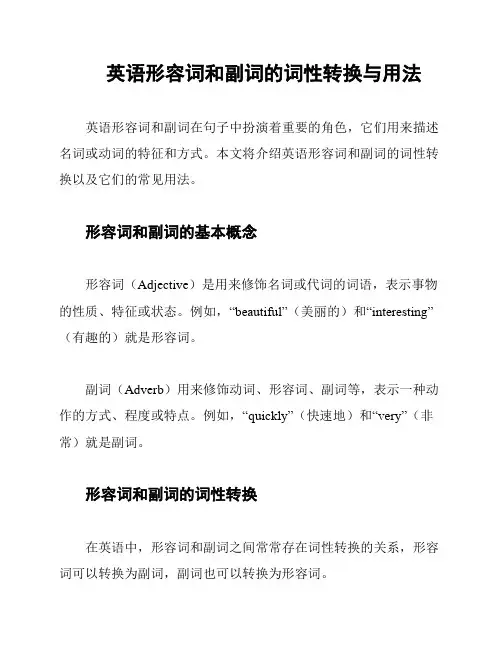
英语形容词和副词的词性转换与用法英语形容词和副词在句子中扮演着重要的角色,它们用来描述名词或动词的特征和方式。
本文将介绍英语形容词和副词的词性转换以及它们的常见用法。
形容词和副词的基本概念形容词(Adjective)是用来修饰名词或代词的词语,表示事物的性质、特征或状态。
例如,“beautiful”(美丽的)和“interesting”(有趣的)就是形容词。
副词(Adverb)用来修饰动词、形容词、副词等,表示一种动作的方式、程度或特点。
例如,“quickly”(快速地)和“very”(非常)就是副词。
形容词和副词的词性转换在英语中,形容词和副词之间常常存在词性转换的关系,形容词可以转换为副词,副词也可以转换为形容词。
形容词转副词形容词转换为副词的一般规则是在词尾加上“-ly”。
例如:- Beautiful(美丽的)→ Beautifully(美丽地)- Quick(快速的)→ Quickly(快速地)- Careful(小心的)→ Carefully(小心地)需要注意的是,并不是所有的形容词都可以直接转换为以“-ly”结尾的副词,有些形容词的副词形式并不规则,需要单独记忆。
副词转形容词副词转换为形容词的一般规则是去掉词尾的“-ly”。
例如:- Slowly(慢慢地)→ Slow(慢的)- Clearly(清楚地)→ Clear(清楚的)- Loudly(大声地)→ Loud(响亮的)同样地,有些副词的形容词形式也不规则,需要单独记忆。
形容词和副词的常见用法形容词和副词在句子中的用法有以下几种情况:1. 修饰名词:形容词可以直接修饰名词,用来描述名词的特征或属性。
例如,“a beautiful flower”(一朵美丽的花)。
2. 修饰代词:形容词可以修饰代词,用来描述代词的特征。
例如,“she is kind”(她很友善)。
3. 修饰动词:副词可以修饰动词,用来描述动作的方式或程度。
例如,“He runs quickly”(他跑得很快)。
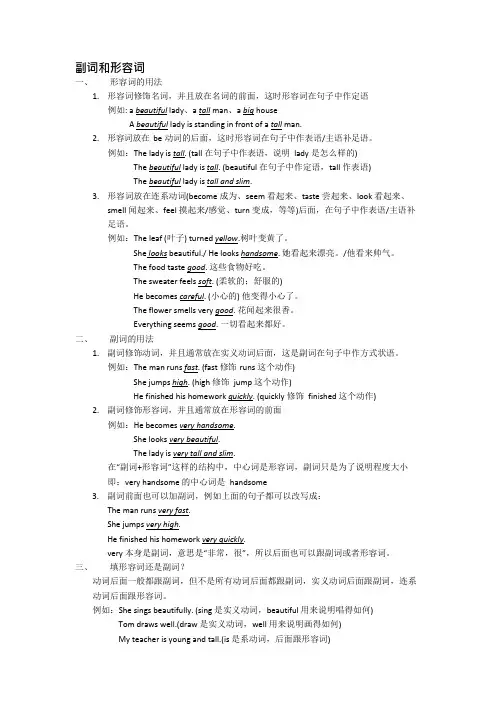
副词和形容词一、形容词的用法1.形容词修饰名词,并且放在名词的前面,这时形容词在句子中作定语例如: a beautiful lady、a tall man、a big houseA beautiful lady is standing in front of a tall man.2.形容词放在be 动词的后面,这时形容词在句子中作表语/主语补足语。
例如:The lady is tall. (tall 在句子中作表语,说明lady 是怎么样的)The beautiful lady is tall. (beautiful 在句子中作定语,tall 作表语)The beautiful lady is tall and slim.3.形容词放在连系动词(become 成为、seem 看起来、taste 尝起来、look 看起来、smell 闻起来、feel 摸起来/感觉、turn 变成,等等)后面,在句子中作表语/主语补足语。
例如:The leaf (叶子) turned yellow.树叶变黄了。
She looks beautiful./ He looks handsome. 她看起来漂亮。
/他看来帅气。
The food taste good. 这些食物好吃。
The sweater feels soft. (柔软的;舒服的)He becomes careful. (小心的) 他变得小心了。
The flower smells very good. 花闻起来很香。
Everything seems good. 一切看起来都好。
二、副词的用法1.副词修饰动词,并且通常放在实义动词后面,这是副词在句子中作方式状语。
例如:The man runs fast. (fast 修饰runs 这个动作)She jumps high. (high 修饰jump 这个动作)He finished his homework quickly. (quickly 修饰finished 这个动作)2.副词修饰形容词,并且通常放在形容词的前面例如:He becomes very handsome.She looks very beautiful.The lady is very tall and slim.在“副词+形容词”这样的结构中,中心词是形容词,副词只是为了说明程度大小即:very handsome 的中心词是handsome3.副词前面也可以加副词,例如上面的句子都可以改写成:The man runs very fast.She jumps very high.He finished his homework very quickly.very 本身是副词,意思是“非常,很”,所以后面也可以跟副词或者形容词。
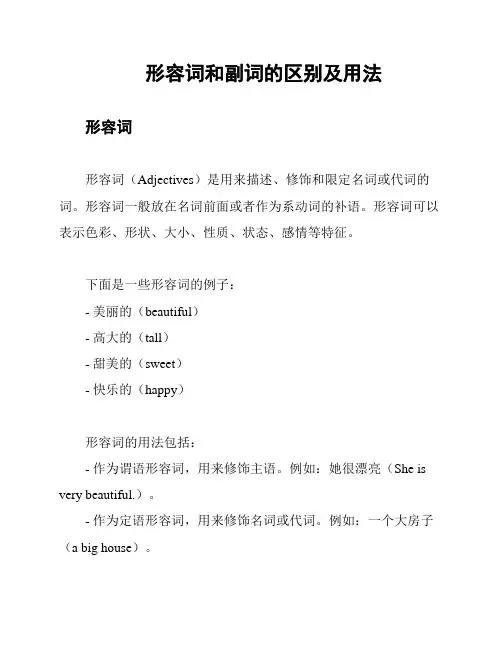
形容词和副词的区别及用法形容词形容词(Adjectives)是用来描述、修饰和限定名词或代词的词。
形容词一般放在名词前面或者作为系动词的补语。
形容词可以表示色彩、形状、大小、性质、状态、感情等特征。
下面是一些形容词的例子:- 美丽的(beautiful)- 高大的(tall)- 甜美的(sweet)- 快乐的(happy)形容词的用法包括:- 作为谓语形容词,用来修饰主语。
例如:她很漂亮(She is very beautiful.)。
- 作为定语形容词,用来修饰名词或代词。
例如:一个大房子(a big house)。
- 作为补语形容词,用来修饰系动词,并与主语有关系。
例如:他很累(He is tired.)。
副词副词(Adverbs)是用来修饰动词、形容词、副词和句子的词。
副词可以表示方式、时间、地点、程度、目的等。
副词一般放在动词、形容词或其他副词前面。
下面是一些副词的例子:- 快速地(quickly)- 非常(very)- 现在(now)- 安静地(quietly)副词的用法包括:- 修饰动词,表示动作的方式、程度、频率等。
例如:他跑得很快(He runs quickly.)。
- 修饰形容词,表示形容词的程度。
例如:这本书很好看(This book is very interesting.)。
- 修饰其他副词,表示副词的程度。
例如:他跑得非常迅速(He runs extremely fast.)。
- 修饰整个句子,表示说话者的态度、时间、地点等。
例如:幸好你来了(Luckily, you came.)。
形容词和副词的区别形容词和副词的主要区别在于它们修饰的词不同。
形容词修饰名词或代词,而副词修饰动词、形容词、副词和句子。
此外,形容词在句子中常常作为定语或谓语使用,而副词在句子中常常作为状语使用。
下面是一些形容词和副词的对比例子:- 形容词:这个小女孩很聪明(The little girl is very smart.)- 副词:她跑得很快(She runs very quickly.)总结形容词和副词在英语中扮演了重要的角色,用来描述、修饰和限定其他词或句子。
比较级&最高级一、分类:形容词和副词有原级、比较级和最高级三级.原级变为比较级和最高级有规则变化和不规则变化两种。
二、规则变化:形容词和副词的比较级和最高级的变化方法如下(1) 符合规则的:(2)几个不规则的形容词和副词的比较级和最高级如下表:三、形容词和副词的原级、比较级和最高级的用法:1e.g。
This room is bigger than that one. I am taller than you。
This lesson is more difficult than that one.注意:①修饰比较级的词有 a little, a bit ,a few , a lot ,much, even,still,far,rather,any 等表程度。
e。
g。
Today is _________ colder than yesterday(冷得多/一点)②为避免重复,在从句中常用the one 代替可数名词单数形式,调和ones 或those代替可数名词的复数形式,that代替不可数名词.E。
g。
The weather in Tianjin is colder than______of Guangzhou in winter.2、表示“…不如…”,用“less+原级+than”结构e。
g. The book is less difficult than that one. The film is less interesting than that one3、不与其他事物相比,表示本身程度的改变,用“比较级+and+比较级”结构,意思是“越来越…”e.g。
The weather is getting______ ______ 。
______ (越来越暖和)Our country is becoming _____ ______ . ______ (越来越漂亮)4、表示“两者之间比较。
形容词与副词的用法形容词和副词是英语中常用的两类词性,它们在句子中分别修饰名词和动词,起到描述事物性质和方式的作用。
正确使用形容词和副词能够使语言更加生动、精确,让表达更加丰富。
下面将详细介绍形容词和副词的用法。
一、形容词的用法形容词用来描述名词或代词,表达它们的性质、状态或特征。
通常形容词在句子中位于名词的前面,用来修饰名词。
1. 形容词的基本用法形容词可以直接修饰名词,起到描述性质或特征的作用。
例如:- A beautiful flower (一个美丽的花)- The tall man (那个高个子男人)形容词也可以用在系动词后面,与主语共同构成系表结构,表示主语的状态或性质。
例如:- The girl is happy. (这个女孩很开心)- He seems tired. (他似乎很累)2. 形容词的比较级和最高级形容词有比较级和最高级两种形式,用来表示事物之间的大小、程度、高低等差异。
一般情况下,单音节形容词在词尾加上-er构成比较级,加上-est构成最高级。
例如:- big - bigger - biggest (大 - 更大 - 最大)- small - smaller - smallest (小 - 更小 - 最小)对于多音节或部分双音节形容词,可在前面加上more或most来构成比较级和最高级。
例如:- intelligent - more intelligent - most intelligent (聪明 - 更聪明 - 最聪明) - beautiful - more beautiful - most beautiful (美丽 - 更美丽 - 最美丽)3. 形容词的修饰顺序当有多个形容词修饰同一个名词时,它们的顺序通常遵循以下规则:限定词 - 描绘性形容词 - 尺寸形容词 - 年龄形容词 - 形状形容词 - 颜色形容词 - 国籍形容词 - 材料形容词 - 用途形容词例如:- A beautiful tall young woman (一个美丽的高个年轻女人)- An old round wooden table (一张古老的圆木桌子)- Three small red Chinese silk dresses (三件小号红色中国丝绸连衣裙)二、副词的用法副词用来修饰动词、形容词、副词、句子以及表示时间、地点和方式等。
英语形容词和副词的用法总结
形容词和副词是英语中非常重要的词汇,它们可以用来描述名词、代词或句子的状态或程度。
下面是对形容词和副词用法的总结:
形容词的用法:
1. 描述名词:形容词用于描述名词的特征或属性,例如“美丽的花朵”、“高大的建筑物”。
2. 修饰名词:形容词可以用来修饰名词,使其更具体或更明确,例如“小汽车”、“美丽的花园”。
3. 强调比较级:在描述两个人或两个事物之间的差异时,可以使用形容词的比较级来强调其中一个的特点,例如“她比他更高”。
副词的用法:
1. 描述动词:副词用于描述动词的行为、动作或状态的方式或程度,例如“他快速地跑”、“她非常开心”。
2. 修饰动词:副词可以用来修饰动词,使其更具体或更明确,例如“他慢慢地走来”、“她突然地跳起来”。
3. 强调比较级:在描述两个人或两个事物之间的差异时,可以使用副词的比较级来强调其中一个的特点,例如“他跑得比她快”。
4. 修饰形容词和副词:副词还可以用来修饰形容词或副词,使其更具体或更明确,例如“非常漂亮的衣服”、“非常快速地跑”。
需要注意的是,形容词和副词的用法有时会有一些重叠,但它们的主要区别在于形容词主要修饰名词,而副词主要修饰动词。
同时,形容词通常放在名词之前,而副词则放在动词、形容词或整个句子之前。
形容词和副词的用法归纳形容词修饰名词,说明事物或人的性质或特征。
通常可将形容词分成性质形容词和叙述形容词两类,其位置不一定都放在名词前面;副词在许多情况下,副词都放在所修饰的动词后面或句末,有时也放在主语后面,谓语动词前面。
11、作定语形容词作定语时通常放在它所修饰的名词前面,称为前置定语,被修饰的名词可称为主体词。
如:The company is in a difficult situation.这家公司正处于困难的境地。
She is a good student,and she works hard.她是一个好学生,她努力学习。
2、作表语同名词一样,形容词也可以用在系动词后面作表语,修饰主语或说明主语的情况。
如:This bike is expensive.这辆自行车很贵。
I am sorry,I'm busy now.对不起,我现在很忙。
3、作宾语补足语We must keep our classroom clean.我们必须保持教室整洁。
We found the film quite instructive.我们发现那部电影很有教育意义。
21.多数副词放在动词后面,或者放在be动词、助动词或情态动词之后,实义动词之前。
如果实义动词后有宾语,则放于宾语之后。
I can also do that.我也可以这样做。
2.副词修饰形容词时,一般放在被修饰词之前,但enough除外。
It's rather easy, I can do it.这很容易,我能做到。
3.频度副词可放在实义动词的前面,情态动词和助动词的后面。
I often help him these days.这些日子我经常帮助他。
形容词副词用法详解形容词是用来修饰名词的词语,它可以表示事物的性质、特点、状态、数量等。
形容词通常位于名词前面,用来描述或限定名词,帮助读者更好地理解名词所表示的事物。
副词是用来修饰动词、形容词、副词等的词语,用来表示动作的方式、程度、频率、时间等。
副词通常位于动词、形容词或其他副词之后。
下面是对形容词和副词用法的详细解释:1.形容词用法:- 形容词可以直接修饰名词,用来描述或限定名词。
例如:a beautiful flower(一个美丽的花)- 形容词可以用来构成比较级和最高级,表示程度的变化。
例如:bigger(更大的)、biggest(最大的)- 形容词可以用在系动词(如be动词)后面,用来描述主语的属性或状态。
例如:She is smart.(她聪明)2.副词用法:- 副词可以修饰动词,表示动作的方式、程度、频率等。
例如:She sings beautifully.(她唱得很好听)- 副词可以修饰形容词,表示程度的变化。
例如:very beautiful(非常美丽)- 副词可以修饰副词,表示程度的变化。
例如:very slowly(非常慢地)- 副词还可以修饰整个句子,表示说话者的态度或观点。
例如:Unfortunately, I cannot go.(不幸的是,我不能去)需要注意的是,有一些形容词和副词的形式相同,只是在句子中的位置和用法不同。
例如:hard(形容词,硬的)和hard(副词,努力地)。
此外,有一些形容词和副词是不规则的,它们的比较级和最高级形式不遵循常规的规则。
例如:good(好的)、better(更好的)、best(最好的)。
总结起来,形容词用来描述名词,副词用来修饰动词、形容词、副词等。
它们在句子中的位置和用法略有不同,但都是用来增强句子的表达能力。
形容词与副词的用法一、形容词的用法。
1、作定语,放在名词的前面。
例如:a big room2、作表语,放在连系动词的后面,构成系表结构。
例如:She feels warm.常见的连系动词有:①be “是”例如: It is big.②feel “感到,摸起来…”例如: Lily feels happy.③look “看起来…”例如: The old man looks tired.④get “变得…..”例如: The weather gets hot.⑤become “变得…..”例如: The story becomes true.⑥turn “变得(用于颜色)…..”例如: When spring comes, leaves turngreen.⑦sound “听起来…..”例如: The song sounds beautiful.⑧taste “尝起来….”例如: The cookies taste nice.⑨smell “闻起来…..”例如: The food smells good.二、副词的用法。
1、修饰行为动词。
例如:Tom runs quickly.2、修饰形容词。
例如:Lily looks quite excited.3、修饰其它副词。
例如:She studies very hard.三、很多形容词可以通过加ly构成副词.1、直接加ly ,例如:slow----slowly2、辅音字母加结尾的,改y 为加i ,例如:happy----happily四、一些词本身既是形容词,也是副词。
例如:early(早), late(迟), high(高), fast(快), far(远)….形容词与副词比较等级的构成:形容词与副词通常有三个等级:即原级, 比较级, 最高级. 它们的变化如下:一、规则变化:1、一般情况下加----er, est. 如:small---smaller—smallest fast—faster--fastest2、以不发音的e结尾的,加—r, ---st. 如:late—later—latest large—larger---largest3、以辅音字母+y结尾的, 把y改为i加—er, ---est.happy---happier—happiest early—earlier—earliest4、以重读闭音节结尾且末尾只有一个辅音字母的,双写末尾辅音字母再加—er,--est.big—bigger—biggest hot—hotter—hottest fat—fatter—fattest thin—thinner—thinnest5、部分双音节和全部多音节形容词与副词在前面加more, most.形容词加ly构成的副词也是在前面加more,most.careful---more careful---most carefulwidely---more widely---most widelyquickly---more quickly—most quicklypopular—more popular---most popular形容词与副词比较等级的用法:1、无比较对象时,用原级。
Eg. Li Ming is tall.2、两者之间进行比较时,用比较级。
常“…比较级+than….”结构. Tom is taller is thanLily3、“比较级+and+比较级” “越来越…..”. eg: It’s getting hotter and hotter.如果遇到多音节词,则用“more and more +多音节词”. Eg: The girl is more and more beautiful.4、“The+比较级…,the+比较级”“越….,就越….”.eg:The harder you study,the more you’ll get.5、在“of the two…”“在…中,较…的…”结构中, 用“….the +比较级+ of the two”.eg: Mike is the younger of the two boys.6、修饰比较级的程度副词有:much/ a lot/far+比较级“…..得多”; even/still+比较级别“甚至,还更….”; a little/a bit+比较级“更….一点”. eg: He is much taller than I.7、同级比较用:①“as+原级+ as”, 表示“和…一样…”eg: This room is as big as that one.②“not as/so+原级+ as”, 表示“(前者)…不如…(后者)”.eg: Lily does n’t run so fast as he.8、三者或者三者以上进行比较,用最高级。
其中,形容词的最高级前,要用定冠词“the”;副词的最高级前,可用定冠词“the”,也可以不用. 另外,最高级的句子一般有“of+人或物的范围”或“in+地点的范围”.He is the tallest boy in his class.9、形容词与序数词连用时,用最高级。
She is the second youngest in the class.10、one of +形容词的最高级+名词的复数.Miss Li is one of the most popular teachers inthe schoolExercises:1.Summer holiday is usually _________ than winter holiday in China.A. longB. shortC. longerD. shorter2.After the dinner, I ate another mooncake. I feel very _______ now.A. fullB. fullerC. fullestD. fully3.The bus is coming ____________.A. near and nearB. nearer and nearerC. nearly and nearlyD. more andmore near4.I am sure you can sing as ____ as last time.A. wellB. goodC. betterD. best5.He looks ____ than he is.A. more youngB. many youngerC. much youngerD. much more younger6.Tom is ______ student in the class.A. betterB. the betterC. bestD. the best7. A train can’t run _____ as a plan.A. so fastB. fasterC. so fasterD. the fastest8.He listened to the teacher ____ than you.A. more carefulB. more carefullyC. as carefulD. as carefully9.This match made them ____ at last.A. happilyB. quicklyC. slowlyD. friendly10.There are _____ chairs in this room than in that one.A. fewerB. lessC. not so manyD. not as many11.Li Lei prefers maths to Chinese. But I think Chinese is much _____.A. usefulB. more usefulC. very usefulD. the most useful12.In this country, it’s very _____ in November but it’s even _____ in December.A. cold; coldB. cold; colder;C. colder; coldD. colder; coldest13.Of all the shoes in your shop, is this pair ____ one?A. very goodB. much betterC. a cheaperD. the cheapest14.I don’t think science is _____ foreign languages.A. as more interesting asB. as interesting asC. as interesting thanD. as interesting15.– You’ve got the same dress as I.-Yes, mine is _____, but not so ____ as yours.A. better, expensiveB. better, more expensiveC. more better, expensiveD. good, more expensive16.I have no time because I’ve ____ work to do and _____books to read.A. many, muchB. many, manyC. much, manyD. much, much17.Most of the people in Guangdong are getting ____.A. richer and richerB. more and more richC. richer and richestD. more rich and more rich18.Our school is becoming ___.A.more beautiful and beautifulB. more and more beautifulC. beautiful and beautifulD. more beautiful and more beautiful19.–Which box is ____, the red one, the yellow one or the blue one?-What do you mean by asking this?A. heavyB. heavierC. heaviestD. the heaviest20.This skirt is _____ for me. I won’t take it.A. too much largerB. too much largeC. much too largeD. much too larger21.Miss Wang is one of ____ in our school.A. a popular teacherB. more popular teacherC. most popular teacherD. the most popular teachers22.Of all these subjects, I like Chinese _____.A. moreB. bestC. wellD. better23.Jack runs as _____ as Tom.A. fastB. fasterC. fastestD. much faster24.Don’t go out. It’s raining _____.A. quicklyB. heavilyC. hardlyD. loudly25.Bob did ____ in the maths exam than Tom.A. badB. badlyC. worseD. worst26.The old writer lives ______ but he doesn’t feel ______.A. alone; aloneB. alone; lonelyC. lonely; lonelyD. lonely; alone27.– Does Mary work carefully?-Yes, I think she works ____ in our class.A. much carefullyB. more carefullyC. most carefullyD. much more carefully28.Mike often talks ____ but does ____. So everyone says he is a good boy.A. less; moreB. few; muchC. more; littleD. little; many29.This kind of skirt looks _____ and sells _____.A. good; niceB. nice; goodC. well; wellD. nice; well30.He eats ___ food, so he is _____ fat.A. much too; too muchB. much too; too manyC. too much; much tooD. too much; many too31.Tom is _____ than all the other students in his class, he is ______ of all.A. taller; tallestB. taller; the tallestC. tallest; tallerD. the tallest; taller。